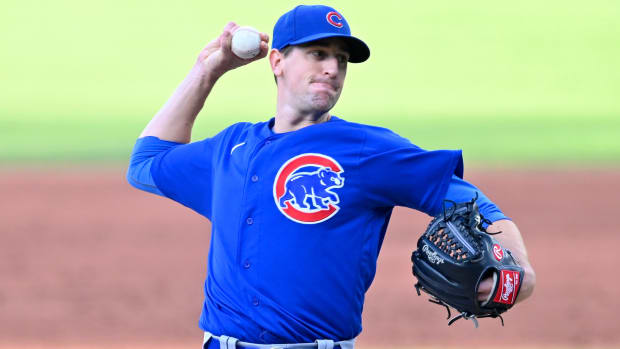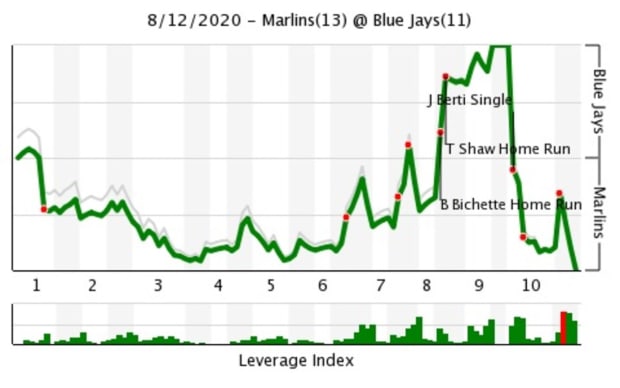The Cubs (12-3) have the best record in baseball entering play Thursday after beating Cleveland on Wednesday. Just how good is Chicago?

The Chicago Cubs (12-3) are off to their best start in 50 years, prompting Cubs fans to ask themselves that age-old question: is this the year?
OK, the days of existential dread and pining for glimmers of hope died when the North Siders finally won the World Series in 2016. But Cubs fans watching this year’s club—one that missed the playoffs a year ago, is led by a rookie manager and has arguably the worst bullpen in the majors—must be wondering whether this team belongs among the upper-echelon World Series contenders.
The Cubs obviously will not maintain their current .800 clip, but let’s examine if they are as good as their hot start suggests.
The Cubs’ bevy of talented position players has performed as advertised, ranking third in combined fWAR. They’re the only team in the majors that has yet to lose consecutive games. Chicago ranks second in the National League in defensive runs saved. And despite that leaky bullpen, the Cubs are a pristine 4-0 in one-run games.
The headliner of the Cubs’ start, though, has been the rotation. Cubs starters rank third in the league in ERA (2.65) and second in fWAR (2.8). Each of the five starters the Cubs have used has outperformed his projections, but how much of those performances can be trusted going forward? Fifteen games is certainly a small sample size, but this is a small sample size season. Rather than ignoring the data in front of us, we can still analyze what’s happened thus far while acknowledging the grain of salt that comes with each statistical nugget.
Let’s begin at the top, with co-aces Yu Darvish and Kyle Hendricks. The duo has ridden opposite approaches to yield very similar results. Darvish’s four-seam fastball has the hardest average velocity (95.4 mph) and spin rate of his career, which has yielded a 42.3% whiff rate and .167 batting average against. Combine that with improved control (3.1% walk rate) and a career-low 26.1% hard-hit rate, and there’s little that looks fluky about Darvish’s performance thus far.
The same conclusion can be drawn for Hendricks, though for different reasons. Hendricks doesn’t throw hard, but his fastball has been every bit as effective as Darvish’s. Hitters are batting .167 with no extra-base hits against Hendricks' four-seamer, which is third-most often used pitch. His average exit velocity, hard-hit rate and expected ERA all rank in the 85th percentile or better, and he’s still excelled at avoiding free passes (career-low 2.6% walk rate) and inducing ground balls (49.4% ground ball rate). The Professor hasn’t changed—he’s just executing his plan as effectively as ever.
Jon Lester might be the most intriguing of the bunch so far. Through three starts, he’s taken the classic pitch-to-contact approach to new extremes. His swinging strike rate (3.9%) ranks as the lowest among qualified pitchers, while his average fastball velocity has declined to the slowest of his career. Hitters are making plenty of contact, but have been unable to do much damage: Lester’s soft contact rate (23.5%) is the sixth-highest in the majors, and his average exit velocity (84.4 mph) ranks in the 94th percentile. At 36, Lester has comfortably entered the “wily veteran” phase of his career. So far, it’s a role that suits him well.
The last two pieces of the rotation carry the most uncertainty. Tyler Chatwood was excellent through two starts but roughed up in the third, fitting for a talented pitcher who’s always been a bit volatile. Alec Mills, filling in for the injured Jose Quintana, has seen his strikeout rate cut in half compared to his previous two seasons, but he has also been a ground ball machine through two starts (54.3% ground ball rate). Mills also has the third-lowest average exit velocity (79.3 mph) in the majors.
But about those relievers. Such a resource will be even more paramount in a playoff series, and the unit’s 6.56 ERA and league-worst 6.22 FIP simply has to improve.
Going forward, Chatwood won’t be as bad as his 5.40 ERA suggests, and Mills won’t keep up his 1.38 mark. The three headliners could very well be in store for some regression as well, but there are compelling underlying reasons to believe their success will continue. Chicago’s rotation has the second-best FIP (2.75) in the Majors, lending even further credence to the notion that the starters’ exceptional play so far has not been a smoke-and-mirrors act that could crumble at any moment.
So fret not, Cubs fans who are bracing for an old-fashioned collapse to come any moment now. This year’s team looks to be for real, but you’ll be forgiven if you’re still waiting for the other shoe to drop—after all, old habits die hard.
Quick Hits:
• Zack Greinke shouted out signals to opposing hitters during a 5-1 win over the Giants, perhaps a show of restitution following the Astros’ infamous sign-stealing scandal (though Greinke did not arrive in Houston until after the cheating had ended).
• Juan Soto hit a ball to space:
It was the hardest-hit homer of Soto’s career (112.9 mph off the bat), and also the farthest (466 feet), topping his home run from Monday by a whopping three feet.
• The Blue Jays and Marlins played in a whopper of a slugfest Wednesday night, with Miami racing to an 8-0 lead in the third inning and eventually leading 11-4 in the fifth before allowing seven unanswered runs to send the game to extras. The Marlins eventually prevailed, 14-11, resulting in a beautifully chaotic win probability chart:

• Mets broadcaster Keith Hernandez attempted to send play-by-play man Gary Cohen a cookie via clothesline during Wednesday’s 11-6 win over the Nationals, proving yet again that (socially distanced) sharing is caring.